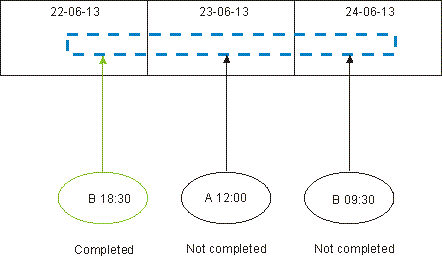The resolution of dependencies in the long-term plan
- For Closest Preceding (C), the interval goes from infinity to the IA time of the successor.
- For Same scheduled date (S), the interval starts on the same day of the IA time of the successor if the IA time is after the start of day defined in the calendar. If the IA time of the successor is earlier or equal to the start of day, then the interval starts the day before. The end is 24 hours later.
- For a relative interval (R), the start and end are offsets specified in terms of hours and minutes with respect to the IA time of the successor.
- For an absolute interval (A), the start and end are specific time boundaries specified for up to seven days before, after, or around the IA time of the successor.
With the exception of C, the other criteria allow for the IA time of a matching predecessor to be searched before, after, or across (where the interval starts before and ends after) the IA time of the successor. When the interval ranges from before to after the IA time of the successor (this is true also for S), the matching predecessor is searched, starting from the IA time of the successor, first by scanning the plan backwards to the start of the interval; if no match is found, the scheduler scans forward from the IA time to the end of the interval.
In situations were a possible match can be found also after the IA time of the successor, the scheduler first checks if there is a match with a completed predecessor before the IA time. If it finds it, it considers the dependency as resolved and does not add it in the plan. For example, operation A with a IA time at noon of 23-06-2013 is defined in the database with B as external predecessor. The match is to be looked for within an absolute interval spanning from 18:00 of the day before to 20:00 of the day after the IA time of A.
- B with IA time equal to 18:30 of 22-06-2013 that has completed.
- B with IA time equal to 09:30 of 24-06-2013 that has not yet completed.

A match is found with the instance of B that completed on 22-06-2013: the dependency is considered solved and is not added to the long-term plan.
At each extension, the long-term plan normally removes all the completed occurrences that precede
the first not completed occurrence (FNONC) of an application. For more flexibility in the management
of dependencies, you can configure the BATCHOPT LTPREMSHIFT(N) parameter to save in
the plan the occurrences that completed within a number of n days, from 0 to 7, before the
FNONC. See Customization and Tuning for
reference on this parameter.
If a dependency was defined in the database as mandatory at plan level (P) and the scheduler does not find a match, the dependency is not resolved and an error is returned. If it was defined mandatory at control level (C), under similar circumstances a mandatory pending predecessor is added to the plan and an informational message is issued. Mandatory pending predecessors can be viewed in both the LIST and detailed panels of the LTP ISPF dialogues (with status equal to M). You can browse and delete a pending mandatory predecessor but cannot create it from an LTP ISPF dialog.
After changing the definition of a dependency from mandatory to non mandatory or vice-versa in the Application Description, be sure to run the Modify the long term plan for all applications batch job to be sure that the change in the database is reflected in the LTP.